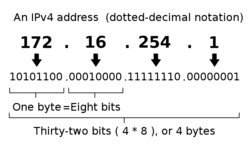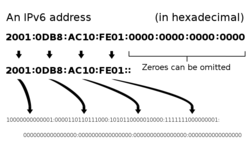Difference between revisions of "IP address"
From FileZilla Wiki
Jump to navigationJump to search (cEVnsR 52. "The road will be overcome by that person, who goes." I wish you never stopped and be creative - forever..!!) |
m (Reverted edits by 193.105.210.170 (talk) to last revision by CodeSquid) |
||
| Line 1: | Line 1: | ||
| − | + | = IPv4 addresses = | |
| + | |||
| + | [[Image:Ipv4 address.svg|right|250px|thumb|IPv4 address, conversion between dotted decimal and binary shown]] | ||
| + | |||
| + | Internally, IPv4 addresses are represented by a 32bit number. To make it easier to work with them a different notation is used to enter and to display IPv4 addresses. Most commonly IPv4 address are represented by the dotted decimal notation which has the form ''a.b.c.d'', with each letter representing an 8 bit number, with ''a'' representing the highest 8 bits of the address and the ''d'' the lowest 8 bits. In other words, an IPv4 address is a sequence of four numbers, each between 0 and 255, separated by dots. Examples for valid IPv4 addresses are ''127.56.24.12'' or ''213.239.222.5''. By contrast, sequences such as ''213.256.222.5'' or ''127.24.12'' or ''127.56.24.12.3'' are not valid addresses. | ||
| + | |||
| + | == Special addresses == | ||
| + | |||
| + | Some address blocks or ranges have been assigned a special meaning. | ||
| + | |||
| + | {| | ||
| + | |+ Reserved address blocks | ||
| + | |- | ||
| + | ! [http://en.wikipedia.org/wiki/Classless_Inter-Domain_Routing CIDR] address block || Range notation || Description | ||
| + | |- | ||
| + | | 127.0.0.1/8 || 127.255.255.255 || Loopback addresses | ||
| + | |- | ||
| + | | 10.0.0.0/8 || 10.0.0.0-10.255.255.255 || Private network | ||
| + | |- | ||
| + | | 172.16.0.0/12 || 172.16.0.0-172.31.255.255 || Private network | ||
| + | |- | ||
| + | | 192.168.0.0/16 || 192.168.0.0-192.168.255.255 || Private network | ||
| + | |- | ||
| + | | 169.254.0.0/16 || 192.254.0.0-192.254.255.255 || Link-local addresses | ||
| + | |} | ||
= IPv6 addresses = | = IPv6 addresses = | ||
Revision as of 20:05, 11 February 2012
IPv4 addresses
Internally, IPv4 addresses are represented by a 32bit number. To make it easier to work with them a different notation is used to enter and to display IPv4 addresses. Most commonly IPv4 address are represented by the dotted decimal notation which has the form a.b.c.d, with each letter representing an 8 bit number, with a representing the highest 8 bits of the address and the d the lowest 8 bits. In other words, an IPv4 address is a sequence of four numbers, each between 0 and 255, separated by dots. Examples for valid IPv4 addresses are 127.56.24.12 or 213.239.222.5. By contrast, sequences such as 213.256.222.5 or 127.24.12 or 127.56.24.12.3 are not valid addresses.
Special addresses
Some address blocks or ranges have been assigned a special meaning.
| CIDR address block | Range notation | Description |
|---|---|---|
| 127.0.0.1/8 | 127.255.255.255 | Loopback addresses |
| 10.0.0.0/8 | 10.0.0.0-10.255.255.255 | Private network |
| 172.16.0.0/12 | 172.16.0.0-172.31.255.255 | Private network |
| 192.168.0.0/16 | 192.168.0.0-192.168.255.255 | Private network |
| 169.254.0.0/16 | 192.254.0.0-192.254.255.255 | Link-local addresses |
IPv6 addresses
Special addresses
| CIDR address block | Description |
|---|---|
| ::1/128 | Loopback address, localhost |
| fe80::/10 | Link-local addresses |
| fc00::/7 | Unique local addresses |
| fec0::/10 | Site-local addresses (deprecated) |
| ::ffff:0:0/96 | IPv4 mapped addresses |

